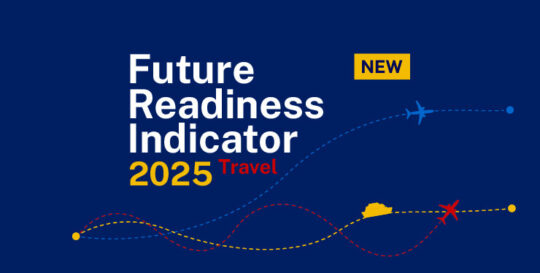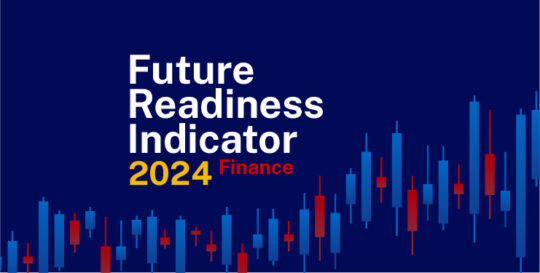IMD business school for management and leadership courses



Future Readiness Indicator
Pharmaceutical Future Readiness Indicator 2023
Which pharmaceutical companies are paving the way for the future? IMD reveals this through a comprehensive analysis.
In the pharmaceutical industry, where advancements and challenges are constant, being future-ready is critical. This concept encompasses a pharmaceutical company’s ability to predict, adapt, and capitalize on emerging health care trends, technological innovations, and regulatory changes.
The sector, especially in the context of the pandemic, is evolving rapidly with significant strides in areas like gene therapy, digital transformation, and artificial intelligence (AI)-driven drug discovery. The capacity to integrate these advancements while maintaining profitability and adhering to strict FDA guidelines is what sets industry leaders apart.
IMD’s Future Readiness Indicator for the pharma industry evaluates companies on seven key factors: financial fundamentals, market growth expectations, product and service diversity, employee diversity and ESG practices, research and development, outcomes of innovation efforts, and the balance of cash and debt. This approach provides a comprehensive assessment of each company’s preparedness for future industry challenges and opportunities.
The focus is not just on big players like Eli Lilly or Pfizer but also on emerging startups redefining the pharmaceutical market with innovative approaches and solutions.
What is a future-ready pharmaceutical company?
Being future-ready in the pharmaceutical industry involves several key aspects.
First, it means embracing innovative technologies to advance medical treatments. Companies like AstraZeneca exemplify this through their use of mRNA technology, which has broad applications beyond vaccines, demonstrating a forward-thinking approach in addressing various health conditions.
A future-ready pharmaceutical company also heavily invests in research and development. This investment is crucial for pioneering new therapies and improving existing ones, ensuring a consistent stream of medical advancements. AstraZeneca’s commitment to R&D showcases its dedication to long-term health care solutions — not just immediate profit.
Lastly, future-ready companies are agile, capable of quickly adapting to new health crises or evolving patient needs. They also uphold high ethical standards and a sense of corporate responsibility, recognizing their crucial role in public health and societal well-being. This comprehensive approach positions them at the forefront of health care innovation.
Pharmaceutical industry rankings
The pharmaceutical industry is on the cusp of a significant transformation. The nature of the drugs hitting the market is changing. Personalized medicine, targeted therapy, digital therapies, and other specialty treatments are increasing in approvals.
The Pharmaceutical Future Readiness Indicator features Pfizer, AstraZeneca, Eli Lilly, and Novartis as top performers. More specifically, 2023 saw a surge in obesity treatment, with Eli Lilly moving up from seventh in 2022 to third in 2023 and Novo Nordisk going from 13th to seventh. Meanwhile, Pfizer moved up from second to first.
Below are our complete 2023 rankings for the pharmaceutical industry.
Click on the company’s name for key factors that make up the score. Drag the slider to adjust the year.
In our ranking table, the “top achievers” are represented by Pfizer, AstraZeneca, Eli Lilly, Novartis, and Roche—whose scores range from an impeccable 100 to a strong 82.3, with only minor score discrepancies among them.
The “average” performers encompass Bristol Myers Squibb through Sanofi, positioned from sixth to 15th, with scores gently descending from 81.0 to 58.4 and no pronounced gaps, indicating a consistent performance within this middle tier.
The “underperformers” category starts with AbbVie at 16th and extends to Teva at 25th, where the scores experience more pronounced declines—notably with a significant drop after Genmab and increasingly wider gaps toward the end of the table—highlighting the challenges within this group.
To arrive at this conclusion, we measured organizations with a balanced scorecard approach because they needed to meet all the near-term demands while scaling up new capabilities for the long term. Find out more about our research methods in the variables we track and how we roll up the calculation.
What were the 2023 pharmaceutical trends?
What distinguished the top performers was their ability to swiftly adapt to changes, solid financial management, and a pool of talented workforce.
The top-performing pharmaceutical companies:
Invest heavily in research to unearth innovative medicines while also maintaining a robust lineup of potential new drugs for future releases.
In May 2023, Gilead Sciences acquired XinThera, a biotech company focusing on oncology and inflammation. Through this acquisition, Gilead gained rights to small molecule inhibitors targeting PARP1 for oncology and MK2 for inflammatory diseases, with potential clinical trials later in the year.
Form partnerships with other entities and research institutions to speed up the development of new treatments.
In 2023, AstraZeneca, through its subsidiary Alexion, signed a significant deal with Pfizer, acquiring a portfolio of preclinical gene therapies and technologies for up to $1 billion. This strategic move indicates a trend toward collaboration and partnership in the pharmaceutical industry to accelerate development in areas like gene therapy.
Deliver medicines to a vast number of patients through a wide reach across the globe and efficient distribution networks.
Pfizer has established a robust global manufacturing and supply infrastructure, enabling the company to provide more than 50 billion doses of medicines and vaccines annually to over 181 countries. This extensive reach makes it possible for Pfizer to reach approximately 1.3 billion patients worldwide.
Exhibit adeptness in navigating complex legal and regulatory pathways to secure approvals for new drugs.
AstraZeneca’s respiratory syncytial virus antibody Beyfortus was highlighted as potentially the biggest blockbuster from the 2023 cohort of FDA approvals, with expected peak sales of $1.9 billion.
Diversify their focus across various treatment areas to keep their business stable and on a growth trajectory.
Biogen’s R&D focuses on areas with great unmet needs, and they have one of the industry’s most diversified pipelines in neuroscience. They recently had the monoclonal antibody lecanemab approved for Alzheimer’s disease.
Additionally, Biogen and Sage Therapeutics announced the FDA’s acceptance of an NDA filing for zuranolone as a treatment for major depressive disorder (MDD) and postpartum depression (PPD).
Maintain a keen focus on patient needs and adopt modern technologies to gain insightful data and enhance operations.
Sanofi is leveraging digital applications, portals, AI, digital biomarkers, data analytics, and evolutive industrial facilities to create a more agile, integrated, and collaborative digital environment. This transformation spans across research and development, manufacturing, supply, and commercial operations.
Align themselves with societal and environmental well-being.
Pfizer has made significant commitments to environmental sustainability, focusing on climate action. They aim to drive down greenhouse gas (GHG) emissions throughout their value chain, pursuing ambitious targets aligned with a 1.5°C pathway.
New capabilities in R&D among top performers
In 2023, pharmaceutical companies significantly enhanced their R&D capabilities by integrating digital technology, data science, AI, and machine learning. These advancements have revolutionized their operations in drug discovery and clinical trials.
For instance, AI models are now focusing on key failure points in the drug development pipeline: selecting the right target in the body, designing the right molecule to interact with it, and determining which patients are most likely to benefit.
These models can sift through vast pools of potential drug molecules, making the drug development process faster and more efficient. Companies like Exscientia are using natural language processing (NLP) to mine data from vast archives of scientific reports and identify promising drug targets.
Notable collaborations and advancements in 2023 included:
- XtalPi and Eli Lilly. Partnered in AI drug discovery, employing XtalPi’s integrated AI capabilities and robotics platform for de novo drug design.
- Sanofi and Aily Labs. Launched an AI app called Plai to deliver real-time, reactive data interactions, providing Sanofi with 360-degree views across its activities.
- AstraZeneca and Verge Genomics. Entered a collaboration to identify new drug targets for rare neurodegenerative and neuromuscular diseases.
New capabilities in supply chain
The skyrocketing demand for weight-loss drugs such as Wegovy, Ozempic, and Mounjaro—recently approved by the FDA to treat obesity under a new name, Zepbound—has surpassed expectations.
The key beneficiaries of this insatiable demand are Eli Lilly and Novo Nordisk. But this scenario of unpredictability in sales volume also underscores the importance and benefits of digital supply chain management in the pharmaceutical industry, especially in terms of responding to demand surges and optimizing supply chain processes to ensure timely and sufficient product availability.
Pfizer’s cold chain service and AstraZeneca’s end-to-end digital supply chain initiatives are particularly notable. Eli Lilly also shows promise with its investments in blockchain and digital twins for better traceability, logistics, and inventory management.
What is the future of the pharmaceutical industry?
The pharmaceutical industry in 2024 is navigating through a dynamic and challenging landscape. Here are some key trends and challenges shaping its future:
- Rising R&D costs. Research and development costs are increasing, pressuring pharmaceutical companies to streamline processes and find ways to reduce costs, including using AI and machine learning.
- Supply chain management. Managing the supply chain is a complex challenge, and pharmaceutical companies are leveraging technologies like blockchain for transparency and traceability.
- Telehealth flexibilities. Regulatory adaptations during the COVID-19 pandemic have led to flexibilities in telehealth, including remote prescription of controlled substances.
- Operations strategy. Pharmaceutical leaders are emphasizing operations strategy, scaling activity across network strategy, resilience, digital, operating model, and talent to deliver value.
- Generative AI for disease detection. Generative AI is becoming vital for early disease detection as predictive analytics unlock new possibilities.
These trends highlight the ongoing evolution and transformation of the pharmaceutical industry, driven by technological advancements, regulatory changes, and market dynamics. The industry is adapting to these changes to stay competitive and meet the growing health care needs of a global population.











